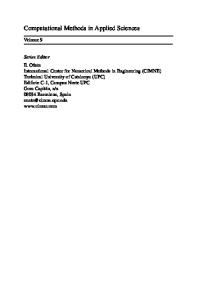Fabrication and Characteristics of Zirconia-Alumina Composites with Bilayer Structure
- PDF / 645,476 Bytes
- 6 Pages / 612 x 792 pts (letter) Page_size
- 46 Downloads / 357 Views
P3.20.1
Fabrication and Characteristics of Zirconia-Alumina Composites with Bilayer Structure Sung-Jae Je1, Myung-Won Lee1, Jae-Ean Lee1, Yeon-Gil Jung1, Dong-Soo Park2, and Ungyu Paik3 1 Department of Ceramics Science and Engineering, Changwon National University Changwon, Kyungnam 641-773, South Korea 2 Ceramic Materials Group, Korea Institute of machinery and Materials, Changwon, Kyungnam 641-010, South Korea 3 Department of Ceramic and Engineering, Hanyang University, Seoul 133-791, South Korea
ABSTRACT Bilayer structures consisting of ZrO2-3mol% Y2O3 (TZ-3Y) and zirconia-alumina composites as inner (substrate) and outer (coating) layers, respectively, are fabricated using gel-casting for the inner layer and dip-coating for the outer layer in aqueous system. The relatively tough TZ-3Y is used as the inner layer for damage absorption due to its mechanical properties. The mixture ratio of alumina/zirconia slips for dip-coating is 1:9, 2:8, and 3:7 as mole ratio. The processing additives for gel casting, such as dispersant, monomer, dimer, and initiator, are adjusted and optimized by measuring viscosity. From which the solid loading of starting material (TZ-3Y) is determined. The optimum amount of dispersant (D-3019; anionic dispersant agent) for TZ-3Y is 0.7 wt%. The slip pH affects the electric double layer in sols, which causes the different rheological behaviors and solid loadings. The castable solid loading of TZ-3Y is 37 vol%, showing a pseudoplastic rheological behavior. The effect of slip type (different mixture ratio) on sintered body is investigated through hardness (Vickers indentation), microstructure (SEM), and strength (4-point bending tests). Strength of sintered bodies after dip-coating into the slips is higher than that before dip-coating, but hardness is not much different among cases. The effects of thickness in the outer layer on damage resistance and mechanical properties of the bilayer structures are discussed extensively.
INTRODUCTION Zirconia has become a rapid development in recent decades and has been taking an active role in many applications, such as ceramic cutting tools, oxygen sensors, and high temperature fuel cells [1]. However, the application of pure zirconia as bulk is not feasible due to the large volume change in transformation from tetragonal to monoclinic phases. Alumina with flexural strength as high as 700 MPs has been prepared by using pure and fine powder [2]. However, fracture toughness of alumina is very low, typically approximately 3 MPa·m1/2, which is much lower than those of other structural ceramics such as zirconia and silicon nitride. Recently, coating systems including layered structure ceramics have become interesting due to the development of multifunctional materials for practical applications [3-8]. Also, gel-casting technique is an attractive new ceramic forming process for making high quality and complexshaped ceramic parts with rapid forming cycle, and good wet and dry strength [5]. Therefore, a new approach to develop and modify ceramic properties is a
Data Loading...









